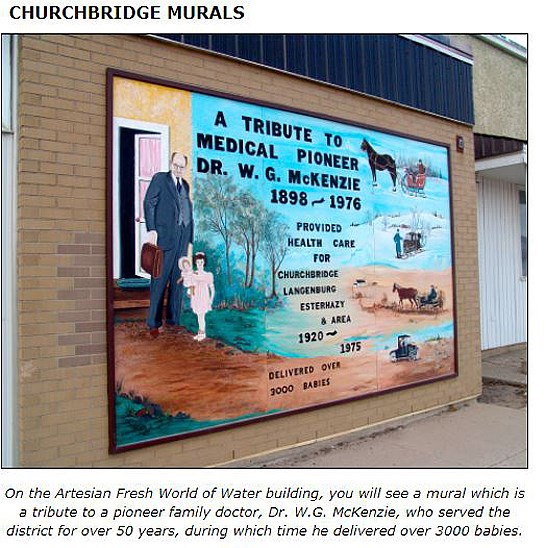Daniel Webster once said, "He who careth not from whence he came, careth little whither he goeth."
On a recent visit to Churchbridge, Saskatchewan I decided to take the Churchbridge Historic Walking Tour and visit all fifteen of the numbered murals. What a delight and what an education!
This little town really treasures its history and has it posted for all to see. I came away knowing more about the history of Churchbridge than the history of the town I have lived in for more than 55 years.
Of course, there were large scenes of life at the turn of the last century - the threshing gangs, hauling water by horsepower, the Saturday night bath in the kitchen in the round tin tub. Nostalgic for me because I remember those times.
The scenes changed to include the unique history of this particular town and this is where my real education began. An Icelandic ship appeared on one wall and signified the year 1885. A clothesline held a large fluffy, feather tick with a few little mice peeking out; and farther down the line, a colourful patchwork quilt fluttered, a corner turned up to show the Union Jack and the year 1878. So, I deduced that Churchbridge's early settlers came from Germany, Iceland and Great Britain. Later, I took a drive down Thingvalla Road to visit an old Icelandic church and graveyard.
I was really impressed with the tributes paid to two of this town's long serving doctors. In a prominent location, there was a pioneer doctor, Dr. W. G. McKenzie 1898-1976 who spent 55 years on the job - providing health care to a large area around Churchbridge, Langenburg, and Esterhazy. He travelled the area by horse and cart in summer and by horse and sleigh in winter until the advent of motor vehicles. Can you imagine the delivery of over 3,000 babies during this time?
Dr. Sheriff Rahaman from Georgetown, Guyana, arrived in 1980 by way of Ireland and Toronto and he stayed for 25 years. His murals were sponsored by an individual family and they had printed THANK YOU! THANK YOU! in capital letters across the top of the first poster.
I enjoyed identifying the birds, animals, and flowers of the area painted on smaller, individual murals #'s 12A to 12H.
High School participation was in evidence in a series of large vertical paintings that may have been done and fastened to a long wall adjacent to an empty lot. These depicted sports prevalent in more recent times. Everything from basketball to ballet. Yes! Ballet. Students signed their names and the grade they were in at the time. Many of these students could be parents or grandparents by now. How proud they must be to see their art still on display.
At the end of the main street there was a small memorial park at the back of which were free standing murals informing the viewer of the highlights of each decade starting in 1905 when Saskatchewan became a province. A clourful First Nation scene was included in this series.
The new mural in downtown Virden is a start to acquaint our citizenry and others of our historical past.
I'm not saying that murals are the only answer to recognizing and paying homage to our past but I do agree with the Chinese Proverb: "To forget one's ancestors is to be a brook without a source; a tree without a root."
Submitted by I. McDougal




